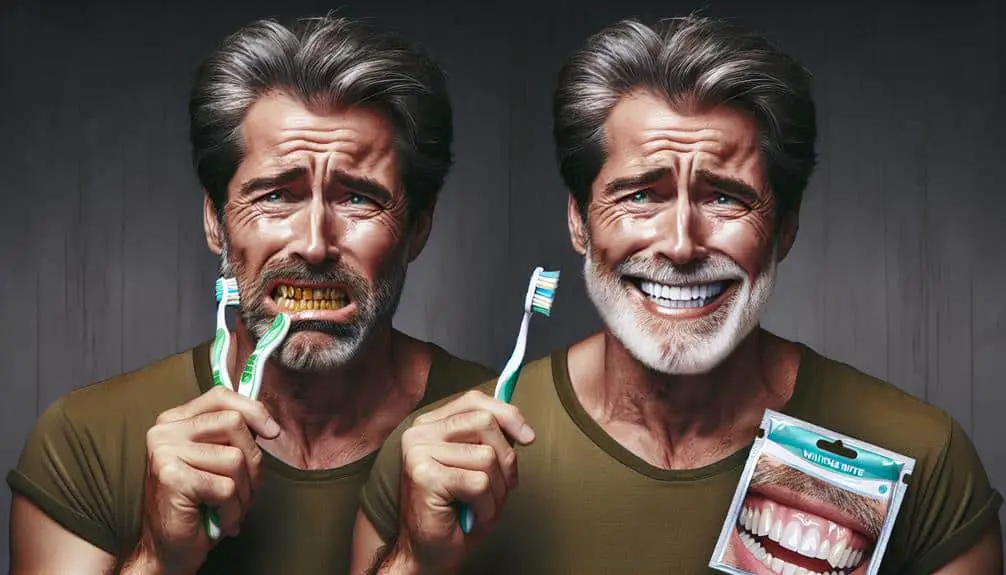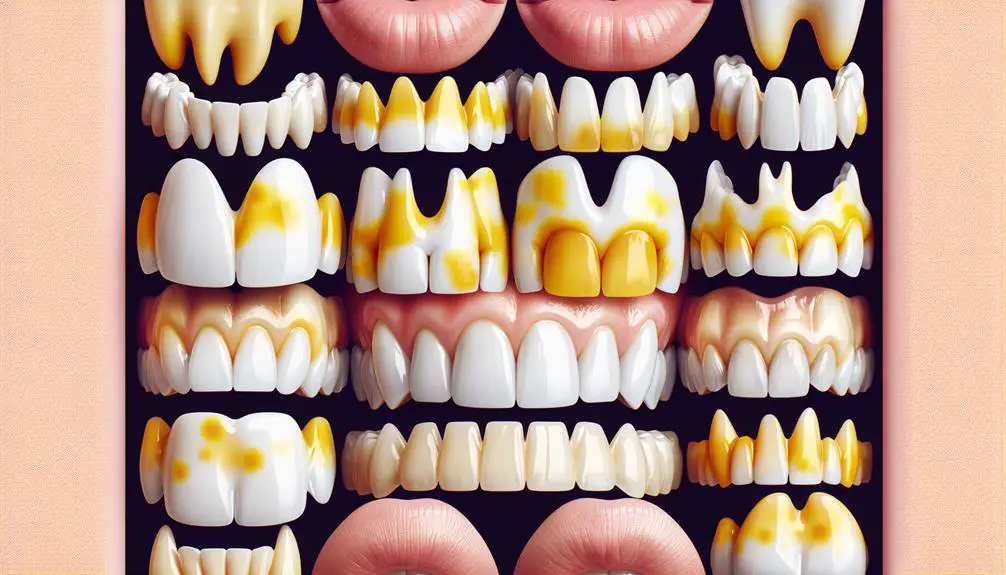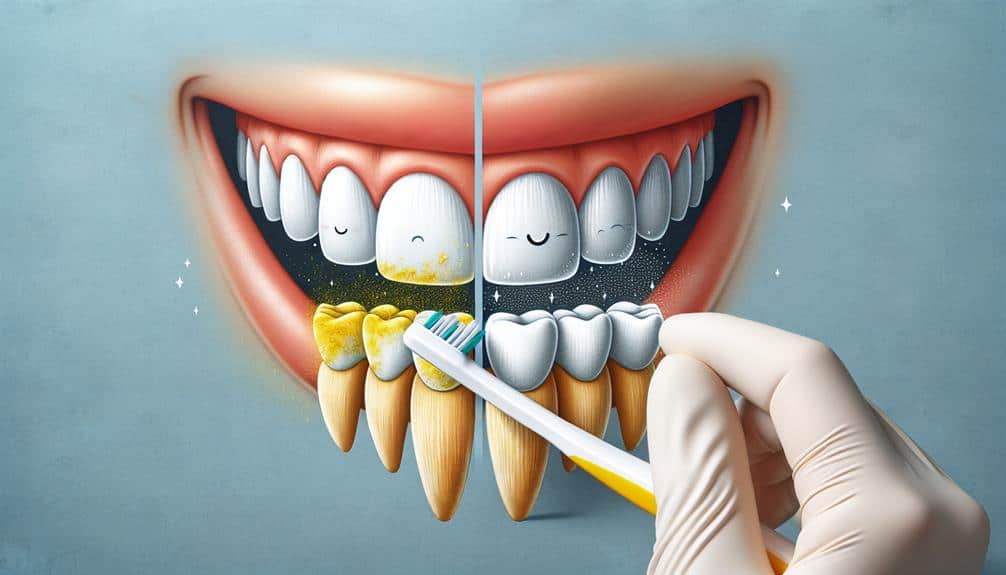To whiten medication-stained teeth effectively, consider professional teeth whitening for expert care. Try at-home whitening kits like DIY strips or lemon juice method for convenience. Use a baking soda paste for gentle stain removal; rinse thoroughly after. Hydrogen peroxide rinse can help but follow safety precautions. Embrace oil pulling with coconut oil for microbial benefits. Try apple cider vinegar rinse as a natural whitening approach. Activate charcoal treatment or whitening toothpaste for noticeable results. Explore strawberries and baking soda paste, a gradual natural remedy. Prevent future staining by avoiding foods like coffee, tea, and red wine. Discover more solutions for brighter smiles.
Key Points
- Professional whitening treatments effective for medication-induced stains.
- At-home whitening kits offer convenience for combating medication stains.
- Natural remedies like baking soda and hydrogen peroxide can help whiten.
- Activated charcoal treatment aids in removing medication-induced stains.
- Preventive measures include avoiding stain-causing foods and maintaining oral hygiene.
Professional Teeth Whitening
When considering professional teeth whitening, consulting with a dentist is crucial to determine the most suitable treatment for your individual needs. Dental bleaching, a common procedure in cosmetic dentistry, is often recommended to address tooth discoloration caused by medication. During the consultation, your dentist will assess the severity of the stains and discuss the various options available to achieve the desired level of whitening.
Professional teeth whitening procedures are typically performed in a dental office under the supervision of a trained professional. One of the most popular methods involves the use of a bleaching agent applied directly to the teeth. This agent helps break down the stains, leaving your teeth looking brighter and more vibrant.
Cosmetic dentistry offers advanced techniques that can greatly improve the appearance of medication-stained teeth. Your dentist will tailor the treatment plan to suit your specific needs, ensuring excellent results. By opting for professional teeth whitening, you can effectively restore the natural brilliance of your smile.
At-Home Whitening Kits
To continue enhancing the whiteness of your teeth, exploring the effectiveness of At-Home Whitening Kits can be a convenient option for maintaining your bright smile. At-Home Whitening Kits offer various methods to help combat medication-stained teeth. The lemon juice method, known for its natural bleaching properties, can be used in these kits to lighten stains effectively. DIY strips are another popular component of these kits, providing a hassle-free application process that can gradually whiten teeth over time.
Additionally, coconut oil pulling, a traditional remedy for oral health, is often incorporated into these kits to help remove surface stains and promote overall dental hygiene. Charcoal powder, although it may seem unconventional, has gained popularity for its ability to absorb toxins and stains from the teeth, offering a promising whitening solution.
When considering At-Home Whitening Kits, it's crucial to follow the instructions carefully to achieve optimal results without causing any harm to your teeth or gums. Experimenting with these different methods can help you find the most suitable whitening solution for your medication-stained teeth.
Baking Soda Paste
To effectively tackle medication-stained teeth, consider utilizing a baking soda paste. This simple mixture can help gently scrub away surface stains when used in conjunction with regular brushing.
Remember to rinse your mouth thoroughly after applying the paste to avoid any potential abrasion on your enamel.
Brush With Baking Soda
Consider using a baking soda paste to brush stained teeth for a natural whitening solution. Baking soda is a popular ingredient in natural remedies and DIY solutions for teeth whitening.
To create a baking soda paste, mix a small amount of baking soda with water to form a thick consistency. Gently brush the paste onto your teeth, focusing on areas with medication stains. Baking soda works as a mild abrasive that can help remove surface stains and discoloration. It also has antibacterial properties that can contribute to overall oral health.
Remember not to use this method too frequently, as excessive scrubbing with baking soda may wear down enamel over time.
Rinse Thoroughly After
For optimal results, make sure to thoroughly rinse your mouth after using the baking soda paste to brush your teeth. Here are three essential steps to follow:
- Brushing Techniques and Proper Timing: After applying the baking soda paste to your toothbrush, gently brush your teeth in circular motions for about two minutes. Be certain you reach all surfaces for an effective clean.
- Water Flossing, Benefits, and Tips: Once you have brushed with the baking soda paste, consider water flossing to remove any remaining particles. Water flossing can reach areas that traditional floss might miss, providing a thorough cleaning experience.
- Rinse Thoroughly: After brushing and water flossing, ensure to rinse your mouth with water to remove any remaining baking soda residue and leave your mouth feeling fresh and clean.
Hydrogen Peroxide Rinse
When using hydrogen peroxide rinse, it's essential to follow safety precautions to prevent any potential harm.
You should dilute the hydrogen peroxide properly to guarantee it's safe for oral use.
Additionally, be mindful of the frequency of hydrogen peroxide rinses to avoid causing sensitivity or damage to your teeth.
Safety Precautions for Rinse
Wondering how to guarantee your safety while using a hydrogen peroxide rinse for whitening medication-stained teeth? Follow these precautionary measures and safe practices to ensure an effective and safe whitening experience:
- Dilution: Always dilute the hydrogen peroxide properly according to the instructions provided. Using it in its concentrated form can lead to irritation and damage to oral tissues.
- Avoid Ingestion: Don't swallow the hydrogen peroxide rinse. In case of accidental ingestion, seek medical help immediately to prevent any adverse effects.
- Rinse Thoroughly: After using the hydrogen peroxide rinse, make sure to rinse your mouth thoroughly with water to remove any residue and prevent potential irritation.
Frequency of Hydrogen Rinse
To maintain ideal whitening results and oral health, understanding the appropriate frequency for using hydrogen peroxide rinse is key in addressing medication-stained teeth concerns.
Frequency management plays an important role in ensuring the effectiveness of hydrogen usage for oral care. Dentists often recommend using a hydrogen peroxide rinse 2-3 times a week to help whiten medication-stained teeth without causing harm to the enamel.
Overusing hydrogen peroxide can lead to tooth sensitivity and irritation of the gums. It's essential to strike a balance between utilizing the whitening properties of hydrogen peroxide and maintaining good dental health.
Consistency in the frequency of rinse application can contribute significantly to achieving desired whitening results while safeguarding overall oral health.
Oil Pulling Method
Consider incorporating oil pulling into your oral care routine to help combat medication-stained teeth. Oil pulling is an ancient practice that involves swishing oil around in your mouth to improve oral health. Here are three essential points to understand about oil pulling:
- Coconut Oil Benefits: Coconut oil is a popular choice for oil pulling due to its known benefits in dental care. The lauric acid present in coconut oil has antimicrobial properties, helping to reduce harmful bacteria in the mouth that can contribute to teeth staining.
- Sesame Oil Pulling: Another effective option is sesame oil pulling, known for its positive impact on oral health. Sesame oil is rich in antioxidants and has anti-inflammatory properties that can aid in whitening medication-stained teeth and promoting overall oral hygiene.
- Procedure: To practice oil pulling, take a tablespoon of your chosen oil and swish it around in your mouth for about 15-20 minutes before spitting it out. Make sure not to swallow the oil, as it may contain harmful bacteria removed from your mouth during the process. Oil pulling can be done daily or a few times a week for best results in combating medication-stained teeth.
Apple Cider Vinegar Rinse
For those seeking a natural approach to combat medication-stained teeth, incorporating an apple cider vinegar rinse into your oral care routine can be beneficial. Apple cider vinegar is known for its various health benefits, including its potential to whiten teeth naturally. The acetic acid in apple cider vinegar helps remove stains on the teeth's surface, making it a popular choice for those looking to brighten their smile without harsh chemicals.
To create an apple cider vinegar rinse, mix one part water with one part apple cider vinegar. Swish this solution around in your mouth for about a minute, being careful not to swallow it. After rinsing, brush your teeth as usual to remove any residual vinegar taste and further aid in whitening.
It's important to note that while apple cider vinegar can help with natural teeth whitening, it should be used in moderation. Overuse of acidic substances like vinegar can potentially erode tooth enamel. Hence, it's recommended to use this rinse only a few times a week to maintain a balance between its benefits and potential risks.
Activated Charcoal Treatment
Activated charcoal treatment offers a natural and effective method for removing stains on medication-stained teeth. This approach can help restore the natural whiteness of your teeth without harsh chemicals. Here are three key points to contemplate when using activated charcoal for whitening:
- Charcoal Toothpaste: Look for toothpaste containing activated charcoal, which is known for its ability to absorb surface stains and toxins. Using charcoal toothpaste regularly can help gradually whiten medication-stained teeth.
- Charcoal Mouthwash: Consider integrating a charcoal mouthwash into your oral care routine. Swishing charcoal mouthwash in your mouth can help target hard-to-reach areas and further remove stubborn stains caused by medication.
- Consistency is Key: To see noticeable results, consistency in utilizing charcoal-based products is essential. Make sure to follow the instructions provided on the products you choose and be patient as the whitening effects may take some time to become apparent.
Whitening Toothpaste
To further enhance the whitening process for medication-stained teeth, exploring the benefits of using whitening toothpaste can be a valuable addition to your oral care routine. Whitening toothpaste is formulated with special ingredients that help remove surface stains caused by medications, leaving your teeth looking brighter. These toothpastes often contain mild abrasives or polishing agents that gently scrub away stains without damaging the enamel.
When choosing a whitening toothpaste, consider one that addresses tooth sensitivity. Some whitening toothpaste formulas incorporate desensitizing ingredients to help reduce discomfort that may arise during the whitening process. Additionally, look for toothpaste that offers enamel protection. Enamel is essential for maintaining tooth strength and protecting against decay, so selecting a toothpaste that strengthens and safeguards the enamel while whitening can be beneficial for your overall oral health.
Strawberries and Baking Soda
Have you ever considered the whitening potential of combining strawberries and baking soda for your teeth? This natural remedy can help brighten your smile by utilizing the natural acidity of strawberries and the mild abrasive properties of baking soda.
Here's how to create your own strawberry masks for teeth whitening:
- Strawberry and Baking Soda Paste: Mash up a ripe strawberry and mix it with a teaspoon of baking soda to create a paste. Gently apply the mixture to your teeth, leave it on for 5 minutes, then rinse thoroughly.
- Strawberry Rub: Alternatively, you can rub a slice of ripe strawberry directly onto your teeth. The natural acids in the fruit can help break down stains, while the baking soda gently buffs them away.
- Regular Use: Consistent use of strawberry masks can gradually lighten surface stains on your teeth. However, remember that natural remedies may take time to show noticeable results, so patience is key when trying this method.
Avoiding Stain-Causing Foods
Considering the impact of your diet on tooth discoloration, being mindful of stain-causing foods is an important step towards maintaining a brighter smile. Making dietary changes can greatly influence the color of your teeth. Foods and beverages such as coffee, tea, red wine, and dark berries are well-known for staining teeth. By reducing the consumption of these items or using a straw to minimize contact, you can prevent further discoloration. Additionally, incorporating maintenance tips like drinking water after consuming stain-causing foods can help wash away any potential pigments before they settle on your teeth.
Lifestyle adjustments play a vital role in preventing tooth discoloration. Brushing your teeth after eating or drinking foods known to stain can help remove surface pigments before they cause lasting damage. Regular dental check-ups and professional cleanings are also essential preventative measures to keep your smile bright. Remember, being proactive in avoiding stain-causing foods and implementing these preventative measures can go a long way in maintaining a white, healthy smile.
Frequently Asked Questions
Can Medication-Stained Teeth Be Whitened Using Natural Remedies or Do They Require Professional Treatment?
To whiten medication-stained teeth, consider using natural remedies first for a gentle approach. If results are not satisfactory, seek professional treatment for more effective and faster solutions, despite potentially higher costs. Prioritize effectiveness over cost.
Are There Any Specific Medications That Are More Likely to Cause Staining on Teeth?
When it comes to medications causing teeth stains, certain types like tetracycline are notorious. Factors like dosage and duration also play a role. Dental professionals can recommend effective stain removal methods tailored to your specific situation.
How Long Does It Typically Take to See Results When Using Natural Whitening Methods for Medication-Stained Teeth?
When using natural whitening methods for medication-stained teeth, you might expect to see results within a few weeks. Common misconceptions include anticipating immediate changes. Consistent use and patience are key for achieving noticeable improvements over time.
Are There Any Specific Precautions to Take When Whitening Medication-Stained Teeth to Avoid Damaging the Enamel?
To protect your enamel while whitening medication-stained teeth, follow precautionary measures like using a gentle whitening toothpaste or seeking professional dental advice. Enamel protection is essential to maintain dental health during the whitening process.
Are There Any Long-Term Effects or Risks Associated With Using Natural Whitening Methods on Medication-Stained Teeth?
When considering natural whitening methods for medication-stained teeth, be aware of potential risks. Long-term effects may include enamel damage or sensitivity. Consult a dentist for personalized advice to safeguard your oral health.



